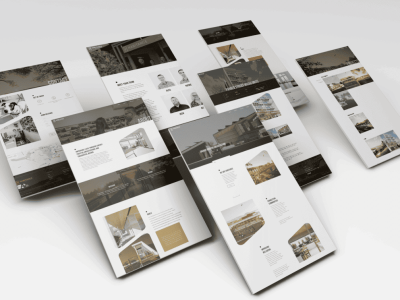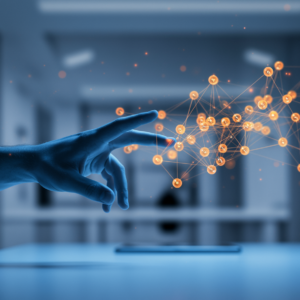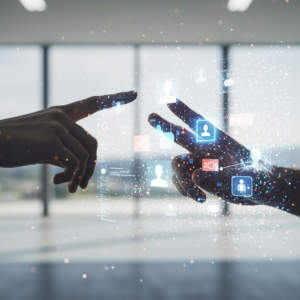Welcome to a journey through the digital transformation ushered in by Artificial Intelligence (AI), particularly its significant impact on web design. As technology advances, the role of AI in crafting modern websites is becoming increasingly indispensable, revolutionizing the field in ways we could only imagine a few years ago. This evolution reflects not just in the aesthetics but in the very foundation of how web experiences are created and delivered.
From the early days of digital design to today’s AI-augmented processes, the progression of web design has been nothing short of remarkable. AI has rooted itself as the backbone of modern web development, offering solutions that cater to an ever-expanding array of user needs and preferences. By leveraging AI, designers and developers are now capable of creating more intuitive, engaging, and personalized user experiences, elevating UX design to new heights.
The impact of AI extends beyond just user experience; it plays a crucial role in enhancing website speed and performance. This technological integration helps websites to become faster and more efficient, significantly improving user satisfaction and engagement rates. Furthermore, AI’s capability to personalize web experiences introduces a new era of customization, where content and designs adapt in real time to meet individual user needs.
The automation of web design processes through AI not only streamlines workflow but also opens up new possibilities for creativity and innovation. This automation allows designers to focus on more strategic aspects of their projects, such as improving accessibility and inclusivity. By employing AI tools, web designers can ensure their websites are accessible to a wider audience, including those with disabilities, making the web a more inclusive space for everyone.
Looking forward, the trajectory of AI in web design points towards an exciting future filled with advancements that promise to further transform the industry. These future trends and predictions hint at an even more AI-integrated approach to web design, where technology and creativity merge to produce groundbreaking results.
As we delve deeper into the transformative power of AI in web design, it’s clear that embracing these innovations is not just beneficial but essential for staying at the forefront of digital experiences. The integration of AI into web design heralds a new era of digital innovation, where the limitations of the past are replaced with endless possibilities for the future.
Content
Introduction to AI in Web Design
The Basics of AI in Web Design
At its core, Artificial Intelligence (AI) in web design refers to the integration of machine learning, algorithms, and automation processes to improve the creation and maintenance of websites. This technology assists in various tasks, from simple color scheme selections to complex user experience enhancements. AI in web design signifies a shift towards more intelligent, efficient, and user-focused digital products, making the web a more adaptive and responsive environment for users worldwide.
AI’s Role in Streamlining Design Processes
AI technologies have revolutionized the way web design processes are carried out, enabling more streamlined, efficient workflows. By automating repetitive tasks, such as code generation and image resizing, AI frees up designers and developers to focus on more complex and creative aspects of web projects. This shift not only accelerates the development cycle but also improves the overall quality and innovation of web design, leading to more dynamic and engaging websites.
Enhancing Creativity with AI Tools
One of the most exciting aspects of AI in web design is its ability to enhance creativity. AI-powered tools can generate design options, suggest layouts, and even predict user preferences, offering a new level of creative freedom and experimentation. This symbiotic relationship between designers and AI tools paves the way for groundbreaking designs that push the boundaries of what’s possible on the web, inspiring a new generation of digital spaces that are both aesthetically pleasing and highly functional.
The Evolution of Web Design with AI
The journey of web design has been profoundly influenced by the advent and integration of Artificial Intelligence (AI), marking a transition from manual, static design processes to dynamic, AI-driven methodologies. Initially, web design was heavily reliant on manual coding and basic design tools, which limited creativity and efficiency. As AI technologies began to emerge, they brought about a paradigm shift, enabling more sophisticated, automated, and personalized web design solutions. This evolution has not only streamlined the design and development process but has also significantly enhanced the user experience, making websites more interactive, intuitive, and engaging.
AI’s contribution to web design evolution is notably seen in its ability to process and analyze vast amounts of data to inform design decisions. Through machine learning algorithms, AI can understand user behavior, preferences, and engagement patterns, allowing designers to create more user-centric websites. This data-driven approach has led to the creation of adaptive and responsive designs that can automatically adjust to meet the specific needs of each user. As a result, websites have become more than just digital brochures; they are now dynamic platforms that offer personalized experiences to their users.
Moreover, the integration of AI in web design has facilitated the rise of innovative technologies such as natural language processing (NLP) and computer vision, which have further expanded the possibilities within the domain. These technologies enable the creation of voice-activated interfaces and image recognition features, enhancing accessibility and user interaction. The continuous advancements in AI are pushing the boundaries of what is possible in web design, shaping a future where websites are not only more intelligent and efficient but also more inclusive and user-friendly.
Understanding the Role of AI in Modern Web Design
Personalization at Scale
One of the most transformative aspects of AI in modern web design is the ability to personalize digital experiences at an unprecedented scale. Leveraging algorithms that analyze user data, AI can tailor website content, layouts, and interactions to individual user preferences and behaviors. This customization enhances user engagement and satisfaction, as websites can now adapt in real-time to serve the most relevant content and suggestions, creating a truly personalized browsing experience that resonates with each visitor.
Automating Design Decisions
AI has been instrumental in automating various design decisions, significantly streamlining the web design process. By employing machine learning algorithms, AI tools can predict optimal design elements, from color schemes and fonts to layout structures. This not only speeds up the design phase but also ensures consistency and coherence across web pages. The result is a more efficient design process that frees human designers to focus on strategic and creative tasks, pushing the boundaries of what’s possible in web design.
Enhancing User Interfaces with AI
The role of AI extends beyond the backend development of websites and into the enhancement of user interfaces (UI). AI technologies like natural language processing (NLP) and computer vision enable the creation of more interactive and accessible interfaces. For example, voice-activated commands and visual search capabilities are becoming more common in web design, providing users with novel ways to interact with digital content. These AI-driven innovations lead to more intuitive and enjoyable web experiences, setting new standards for usability and accessibility in modern web design.
Transform your business with custom AI solutions from a leading Artificial Intelligence Agency.
AI-Driven User Experience (UX) Design
The incorporation of AI into User Experience (UX) Design marks a significant leap forward in creating more intuitive and engaging websites. AI-driven UX design focuses on leveraging machine learning and data analysis to deeply understand user behaviors, preferences, and pain points. This approach enables designers to craft experiences that are not just visually appealing but also incredibly personalized and user-friendly. By analyzing large datasets, AI can identify patterns and insights that inform design strategies, ensuring that every element of a website is optimized for the best possible user experience. As a result, websites become more than mere information platforms; they evolve into dynamic environments that anticipate and meet users’ needs in real-time.
AI-driven UX design also facilitates a more iterative and responsive design process. Traditional UX design methods often involve a lot of guesswork and assumptions about user behavior, followed by time-consuming A/B testing to refine the design based on user feedback. However, with AI, this process becomes much more efficient. AI tools can quickly test numerous design variations, learning from each interaction to continually improve the user experience. This not only accelerates the design process but also enables a level of customization and responsiveness that was previously unattainable. Users benefit from more seamless, frictionless web experiences that are tailored to their individual interactions and preferences.
Furthermore, AI’s role in UX design extends to enhancing accessibility, a critical aspect of creating inclusive web environments. Through technologies such as natural language processing and computer vision, AI can help make websites more accessible to users with disabilities. For instance, AI can automatically generate descriptive alt text for images, enabling visually impaired users to understand visual content through screen readers. Similarly, AI-driven voice recognition can facilitate easier website navigation for users with physical impairments. By embedding these AI capabilities, UX designers are not only improving the usability of websites but are also ensuring that digital spaces are open and accessible to all users, embodying the inclusive spirit of the internet.
Experience effortless, cost-effective social media management with AI technologies
The Impact of AI on Website Speed and Performance
Optimizing Loading Times
One of the most tangible benefits of integrating AI into web design is the significant improvement in website loading times. AI algorithms are engineered to optimize the delivery of website content, from streamlining code to compressing images without compromising quality. By intelligently caching content and preloading resources based on user behavior predictions, AI ensures that websites load faster, providing a smoother experience for visitors. This optimization is crucial not only for user satisfaction but also for improving a website’s search engine ranking, as faster loading times are a key factor in SEO performance.
Adaptive Content Delivery
AI takes website performance to the next level by enabling adaptive content delivery, a method that tailors the way content is served based on the user’s device, location, and browsing conditions. For example, an AI system can detect a user accessing a site from a mobile device on a slow network and can adjust by offering a lighter version of the site or prioritizing the loading of essential content. This intelligent content adaptation ensures that all users, regardless of their access conditions, enjoy a seamless browsing experience, significantly reducing bounce rates and enhancing engagement.
Automated Performance Monitoring and Optimization
Continuous monitoring and optimization of website performance are made feasible and efficient with AI. Utilizing machine learning algorithms, AI tools can continually assess a website’s performance metrics, identify issues like slow loading pages or broken links, and even implement fixes in real-time. This proactive approach to performance management minimizes downtime and technical issues, ensuring that websites remain accessible and performant around the clock. By automating these tasks, AI allows web developers and designers to focus on innovation and user experience, trusting AI to maintain the technical health of their digital properties.
AI and Personalized Web Experiences
The integration of Artificial Intelligence (AI) into web design has heralded a new era of personalized web experiences, revolutionizing the way users interact with digital content. AI enables websites to offer personalized content, tailored recommendations, and unique user journeys for each visitor, based on their behaviors, interests, and past interactions. This level of personalization transforms the user experience, making it more engaging and relevant. By leveraging data analysis and predictive algorithms, AI can dynamically adjust the content, layout, and even functionality of a website in real time to meet the individual needs of each user. This not only increases user satisfaction and engagement but also significantly boosts conversion rates by delivering a more compelling and user-centric online experience.
Beyond mere content customization, AI-driven personalization extends to the aesthetic and functional aspects of web design. It can automatically modify visual elements such as themes and color schemes to suit the preferences of the user or adapt the navigation and interface elements for optimal usability. This deep level of personalization is achieved through continuous learning algorithms that refine their understanding of user preferences over time, ensuring that each visit is more tailored and intuitive than the last. As a result, users feel a stronger connection to the website, perceiving it as more than just a platform but rather a personalized digital space crafted specifically for them.
Moreover, AI’s capability for delivering personalized web experiences opens up new opportunities for businesses to understand and cater to their audience better. Through AI’s analytical power, companies can gain insights into user behavior and preferences, enabling more effective targeting and segmentation strategies. This data-driven approach not only enhances the user experience but also drives business growth by aligning website offerings more closely with user needs. The symbiosis between AI and web design not only elevates the user experience to new heights but also redefines the relationship between businesses and their digital audience, making it more personalized, engaging, and productive.
Elevate your business with DIGITALON AI’s custom AI services and solutions.
Automated Web Design Processes with AI
Streamlining Design and Development
The introduction of AI into web design processes has brought unprecedented efficiency, greatly streamlining both the design and development phases. AI-powered tools and platforms can automate repetitive tasks that traditionally consumed a considerable amount of time, such as coding basic layout structures, optimizing images, and generating responsive designs. This automation frees designers and developers to focus on more complex, creative aspects of web projects, enhancing productivity. Moreover, AI can help enforce design consistency across a website, ensuring that all elements adhere to predefined guidelines and styles, thus maintaining a cohesive user experience.
Enhanced Prototyping and Testing
AI technologies have revolutionized the prototyping and testing stages of web design, significantly accelerating the iteration process. With AI-driven tools, designers can quickly create complex interactive prototypes that closely simulate the final product, allowing for early user testing and feedback. AI algorithms can also automate the testing of different design versions, analyzing user engagement and effectiveness to inform design decisions. This capability enables a data-driven approach to design, where decisions are made based on actual user interactions rather than assumptions, leading to more user-centric websites that effectively meet their target audience’s needs.
Content Generation and Management
One of the most time-consuming aspects of web design is content creation and management. AI assists in this area by automating content generation, from writing descriptive product texts to creating engaging blog posts relevant to the site’s audience. AI can also help organize and manage web content, ensuring that it is updated, relevant, and optimized for search engines. Through natural language processing and machine learning, AI can generate content that is not only grammatically correct but also tailored to resonate with the intended audience, enhancing the overall appeal and effectiveness of a website.
AI in Web Accessibility and Inclusivity
The importance of web accessibility and inclusivity cannot be overstated, and AI technologies play a crucial role in advancing these principles. By integrating AI into web design, developers can create websites that are more accessible to individuals with disabilities, ensuring that digital spaces are open to everyone. AI-powered solutions, such as voice recognition and natural language processing, enable users to interact with websites through voice commands, making the web more accessible to those with visual impairments or physical disabilities that limit keyboard and mouse use. Moreover, AI can automatically generate alt texts for images and transcribe audio content into text, providing equivalent alternatives for users who rely on screen readers. This proactive approach to accessibility not only enhances the user experience for a significant portion of the population but also aligns with legal standards and principles of digital inclusivity.
Furthermore, AI contributes to web inclusivity by breaking down language barriers that have traditionally limited access to information. Through advanced machine learning models, AI can provide real-time website translation, allowing users to access content in their preferred language. This capability is especially valuable in a globalized world, where users from diverse linguistic backgrounds interact with digital content daily. AI-driven translation ensures that websites can serve a broader audience, fostering a more inclusive and multicultural online community. By making the web more accessible and inclusive, AI technologies promote equality and diversity in the digital realm, ensuring that all users, regardless of their physical abilities or linguistic background, can benefit from the wealth of information and services available online.
In addition to enhancing accessibility for individuals with disabilities and non-native speakers, AI also personalizes the user experience to accommodate a wide range of preferences and needs. For instance, machine learning algorithms can adjust the color contrast and font sizes of web content based on the user’s vision impairments or personal preferences, further contributing to a web environment that is inclusive and adaptive to individual requirements. This level of personalization ensures that the web is not merely usable but genuinely welcoming to all users, setting a new standard for inclusivity in the digital age. AI’s role in promoting web accessibility and inclusivity reflects a broader commitment to creating a more equitable and open digital world, where everyone has the opportunity to participate fully and benefit equally from online resources and services.
The Future of AI in Web Design: Trends and Predictions
Intelligent Design Assistants
The future of AI in web design is poised to introduce intelligent design assistants that go beyond mere suggestion tools, evolving into proactive participants in the design process. These AI-driven assistants will be capable of generating complete website designs from scratch, based on brief descriptions or goals inputted by the user. They will understand the nuances of design principles, user engagement strategies, and best practices for SEO, essentially acting as co-creators that can offer refined design options, optimize layouts for user experience, and even predict future design trends. This will not only speed up the design process but also open up new avenues for creativity and innovation, enabling designers to explore unprecedented design possibilities.
AI-Powered User Behavior Prediction
As AI technologies become more sophisticated, their ability to predict user behavior with high accuracy will significantly impact web design strategies. Leveraging vast datasets and machine learning algorithms, AI will provide insights into future user actions, enabling designers to create web experiences that are several steps ahead of user needs and expectations. This predictive capacity will transform how websites are structured, making them more intuitive and seamlessly aligned with the visitor’s journey. Design elements could adapt in real time to the predicted next steps of a user, offering a fluid and highly personalized browsing experience that could dramatically increase engagement and conversion rates.
Enhanced Collaboration between AI and Human Creativity
The intersection of AI and human creativity is where the future of web design holds the most promise. AI will not replace human designers but will enhance their capabilities, creating a collaborative ecosystem where AI’s data-driven insights and automation capabilities augment human creativity and intuition. This partnership will facilitate the creation of more complex, nuanced websites that blend the best of both worlds: AI’s efficiency and scalability with human empathy and aesthetic sensibility. New tools and platforms will emerge to facilitate this collaboration, offering environments where designers can interact with AI in real-time, tweaking AI-generated designs or drawing on AI insights to inform their creative decisions. This harmonious integration of AI within the creative process is likely to redefine the standards of web design, pushing the boundaries of what’s possible in creating engaging, intuitive, and beautiful web experiences.
Conclusion: Embracing AI in Web Design for Innovation
Embracing AI in web design represents a forward-thinking approach to crafting digital experiences that are not only efficient and dynamic but also deeply personalized and accessible. The integration of AI into the web design process heralds a new era of innovation, where the boundaries of creativity and functionality are constantly expanding. As AI technologies evolve, they offer unparalleled opportunities for designers and developers to push the limits of traditional web design, creating websites that are more responsive, intuitive, and tailored to the individual needs of users. This transition towards AI-driven design processes is not just about keeping pace with technological advancements; it’s about actively leveraging these tools to set new standards in user experience, making the web a more inclusive, engaging, and seamless space for everyone.
The potential of AI in web design extends beyond automation and efficiency. It invites a reimagining of the role of the designer, transforming them from creators into orchestrators of complex, AI-enhanced design ecosystems. As AI takes on the heavy lifting of data analysis, optimization, and even aspects of content creation, designers are free to focus on innovation, strategy, and the exploration of new design paradigms. This shift does not diminish the importance of human creativity; rather, it amplifies it, enabling designers to leverage AI insights and capabilities to create truly groundbreaking work. In this environment, the partnership between human designers and AI becomes a powerful force for innovation, driving the development of web experiences that are more engaging, effective, and aligned with user expectations than ever before.
As we look to the future, the integration of AI in web design promises not just incremental improvements but a fundamental transformation in how we conceive of and interact with digital spaces. This shift requires a willingness to embrace new technologies, a commitment to continuous learning, and an open-minded approach to design. By doing so, designers, developers, and businesses can unlock the full potential of AI to create web experiences that are not only beautiful and functional but truly intelligent. The journey towards AI-enhanced web design is an exciting opportunity to redefine what is possible, paving the way for a future where websites are not just seen and used but experienced in deeply personal and meaningful ways.
Key Takeaways
As we explore the vast possibilities ushered in by the integration of AI into web design, it’s clear that we stand on the cusp of a transformative era. This exciting juncture promises to redefine our interactions with the digital world, making them more intuitive, personalized, and inclusive. The journey ahead for web designers and developers, enriched by AI’s capabilities, is not without its challenges, but it is one filled with untold potential for innovation and creativity. By embracing AI, the web design community can pioneer new frontiers in digital experiences, crafting spaces that not only meet but exceed user expectations. Thus, the future of web design, buoyed by the power of AI, beckons us towards a horizon where the potential for creating engaging, efficient, and revolutionary web experiences is boundless. Let us move forward with curiosity and enthusiasm, ready to shape a future where technology and creativity converge to make the digital world more accessible and captivating for all.























